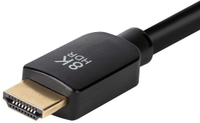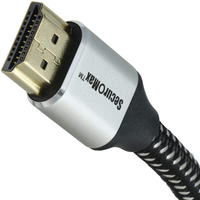The best HDMI 2.1 TVs
Make 4K/120Hz happen on one of the best HDMI 2.1 TVs
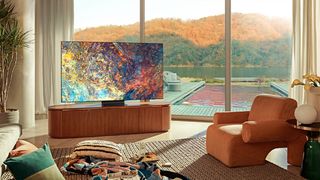
Gamers rejoice! We've corralled the best HDMI 2.1 TVs so you won't have to scour specs pages and internet forums in search of the right display for your new console or PC.
Utilizing an HDMI 2.1 connection gifts you the keys to exceptional speeds and clarity while gaming. Looking to get the most out of your brand-new PS5 or Xbox Series X? Maybe you just picked up one the best gaming PCs and want to pair it with a viable display that allows you higher FPS marks without leaving you in the dust?
The best HDMI 2.1 TVs will get you there, specifically hitting that sweet spot of 120 frames at 4K resolution. How could you not be excited for this world of wonder in gaming? Thanks to the TV's native 120HZ refresh rate and VRR, you'll have the best possible window into gaming experiences without any frame drops or screen tearing.
But not every HDMI 2.1 TV is made the same. You may want even more than just two inputs for the standard, or a TV that has a worthy backbone behind it for gaming specifically. These displays, after all, aren't exactly the best gaming TVs, but do offer you some powerful performance for the pastime.
The best HDMI 2.1 TVs you can buy
Why you can trust Tom's Guide


Specifications
Reasons to buy
Reasons to avoid
The LG C3 OLED is marked as arguably among the best TVs bar none. It provides an exceptional value at a relatively small price point and doesn't slouch with its specs. You can pick up the C3 OLED at the 65-inch mark for just over $1,000, yet despite that price tag you can expect some value gaming specs, most notable among them being a total of four HDMI 2.1 ports.
Color is on full display with the C3 OLED. While the brightness numbers aren't exactly something to write home about, it sports a Delta-E of 1.3, which means it has exceptional color accuracy. Just look at its 99.09 percent coverage of the Rec. 709 gamut to see you'll have plenty of color, and it doesn't change much with HDR content, either.
Given it's among the best HDMI 2.1 TVs, it will need some serious gaming legs, which it can hit thanks to its VRR and ALLM support, plus screen tearing technologies only add to the list, like Nvidia G-Sync and AMD FreeSync Premium. At 12.9ms, the C3's input lag isn't a slouch, either.
It's hard to really beat the value of the LG C3 OLED and all it has to offer. You won't find many other TVs that can hit as many sweet spots at its price nor look so good in the process. All signs seemingly point to an LG C4 OLED that's got loads more to offer, most notably in the brightness department.
Read our full LG C3 OLED review.

Specifications
Reasons to buy
Reasons to avoid
Taking up after the U8H, the Hisense U8K Mini-LED TV comes in with stellar promise in showing just how far the company aims with its Mini-LED panels and TV chipsets. But what makes the Hisense U8K such an incredible HDMI 2.1 offering is its price of just $700 for its 65-inch model.
Where most TVs fall flat, the Hisense U8K stands tall thanks to a 2.1.2 channel speaker system that packs quite the punch. Looking to get one of the best soundbars for your TV? Don't bother, because the U8K comes equipped with Dolby Atmos and gifts your content and games that extra oomph where it matters most.
While you would like to see an input latency under the 10ms mark, the Hisense U8K hits just above that at 13.2ms, which isn't bad in the least. Plus, it comes equipped with AMD FreeSync Premium Pro, allowing you to game at the highest potential without any screen tearing.
As not only one of the best TVs under $1,000 and among the best HDMI 2.1 TVs, the Hisense U8K is one you definitely don't wanna skip if you're looking to game at the highest degree and with ample color.
Read our full Hisense U8K Mini-LED TV review

Specifications
Reasons to buy
Reasons to avoid
Although the Samsung S95D is soon to debut, we won't have any particulars on its numbers and potential as one of the best HDMI 2.1 TVs for a time. But its older sibling, the Samsung S95C OLED TV, is a perfect fit thanks to its incredible panel, serious specs, and gaming performance.
You are, however, paying quite the premium for this OLED TV. It starts at around $1,800 for its 55-inch model, making it quite the investment. At this price, you're getting four total HDMI 2.1 inputs, a Delta-E of 1.4, input lag of 9ms, and HDR brightness that hits 1,370 nits — all making it a stellar display for everything from gaming to simple movie-watching.
The Samsung S95C does, however, lack Dolby Vision, but it does have Dolby Atmos support, which means you might want to go looking for one of the best Dolby Atmos speakers if you're in need of some surround sound exploits.
Read our full Samsung S95C OLED TV review.
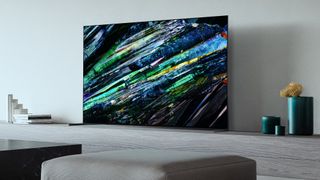

Specifications
Reasons to buy
Reasons to avoid
Sony's designs prove to bring the flavor in everything from color, sound, and general performance, best of all witnessed in its Bravia XR A95L OLED TV. Like the Samsung S95C before it, the A95L will also be quite a hefty investment, but it brings to the table a blend of quantum dots and OLED technology, meaning you get the raw colors and high brightness of both panel technologies.
Strangely, despite making one of the best next-gen consoles in the PS5, Sony's TVs often lack in input latency, with the A95L sporting a rather high 16.1ms of lag. Add to that the fact that it only comes equipped with two HDMI 2.1 inputs and you probably might cringe at its over $2,000 price point.
However, it's totally worth the money thanks to its color accuracy, brightness output, and feature set, which comes with all the HDR tech you could ever ask for. In HDR content, it sports a respectable 99.95 percent of the UDA-P3 scale and brightness of 1,215.
Sony's commitment to bringing the best display tech to market shows no bounds, as proven by its new secret weapon against Samsung and LG in Mini-LED backlights. If you're in the market for one of the best HDMI 2.1 TVs, the Sony Bravia XR A95L OLED TV is your ticket to winning.
Read our full Sony Bravia XR A95L QD-OLED TV review.
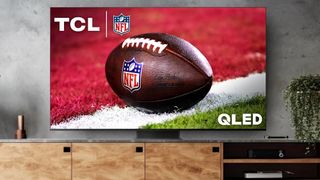
Specifications
Reasons to buy
Reasons to avoid
TCL has been ever on the rise in its attempts to bring to market some alluring TVs with specs that take on major competitors like LG and Samsung at still affordable prices. Enter the TCL QM8 Mini-LED TV, a budget display with some serious firepower, including brightness specs that topple several LG models.
Glare is all but nonexistent on the QM8 thanks to its insane 2,201 nits of HDR brightness, which is just as good in standard content at 1,348 nits. Color accuracy might be just a tad low due to a Delta-E of 3.2, but with both a Rec.709 and UHDA-P3 coverage of near-97 percent, you won't have any issues watching either standard or HDR content.
But what about its gaming potential? The TCL QM8 uses a 144HZ refresh rate, which allows you the potential of serious FPS on a gaming PC. Of course, ALLM and VRR also round out its underlying gaming technologies, plus AMD FreeSync gives it that much needed protection against screen tearing.
There's no question the QM8 comes as among the best HDMI 2.1 TVs, but it does only have two ports of the input standard. It's a hard bargain to beat at just $1,149 for its 65-inch model, though.
Read our full TCL QM8 Mini-LED TV review.
What is HDMI 2.1?
HDMI has been around for several years, but while the HDMI ports on your 4 or 5-year-old TV may look the same as the ports on the top models listed here, not all HDMI connections offer the same functionality.
The latest HDMI standard is HDMI 2.1, which features increased bandwidth (48 Gbps) to move a lot more data. With nearly three times the bandwidth of HDMI 2.0 (18 Gbps, or enough for 4K video at 60 frames per second). HDMI 2.1 supports uncompressed 8K video at up to 60 Hz, or 4K video at up to 120 Hz.
It's essentially a much larger pipe for information back and forth from video sources such as 4K Blu-ray players and game consoles and out to other devices, such as soundbars. That increased data allows for higher resolutions and higher frame rates, making it essential for 8k TVs and high frame rate 4K gaming.
Other key features include:
Auto low latency mode (ALLM) detects when a game console is connected or powered on, and allows the TV to automatically switch to game mode, turning off unnecessary video processing to reduce lag times. It's one less step you'll need to take before getting into your game.
Variable refresh rate (VRR) uses adaptive sync technology similar to Nvidia G-Sync and AMD FreeSync, aligning the TVs refresh rate with the frame rate of a connected game console. By matching refresh rate to frame rate, the TV is able to play games with perfect smoothness, eliminating any judder or screen tearing that can be caused by new frames rendering mid refresh.
Enhanced audio return channel (eARC) is another great feature offered on HDMI 2.1 (but not exclusively, it can also be found on the more common HDMI 2.0 connection) which allows you to use a single HDMI cable to connect a TV to a soundbar or other audio equipment, without requiring additional cables. ARC allows a downstream connection over HDMI, meaning that you can use one of your regular HDMI connections to output audio to a soundbar. With the higher bandwidth and HDMI 2.1, ARC technology is updated and enhanced to support uncompressed audio formats, such as Dolby Atmos. (Read our article What is HDMI ARC? to learn more.)
Who needs HDMI 2.1?
There are a few instances where HDMI 2.1 will be indispensable, with features that require the new high bandwidth connection.
The first is gaming. If you want to get the best possible performance from a new PS5 or Xbox Series X, you'll need to take advantage of the console's HDMI 2.1 connectivity, and that means using a TV that has HDMI 2.1, and using a compatible HDMI cable. Features above like ALLM and VRR are only available in the 2.1 spec, so we firmly recommend HDMI 2.1 for anyone looking for the best gaming TVs.
Secondly if you've forked out for a Dolby Atmos soundbar (after reading our best soundbars in 2022 article, of course), HDMI 2.1 ports will offer you eARC as standard, meaning your soundbar can receive an uncompressed Dolby Atmos soundtrack from your TV, for the best possible audio performance.
What about 8K TVs with HDMI 2.1?
8K early adopters will need HDMI 2.1. As the first single HDMI connection capable of carrying 8K resolution at watchable frame rates, HDMI 2.1 is indispensable for 8K. Or it will be, whenever 8k media really arrives.
For the time being, there is nothing noteworthy, which is why we don't recommend 8K TVs at this time. There are no 8K-enabled media players or game consoles either, so it's kind of a moot point. Sure, the Xbox Series X and PS5 can handle 8K in theory, but it's not enabled yet. And even if it were, there's a big doubt about whether we will see 8K native gaming any time soon.
When 8K media does arrive – and it's not a matter of "if" but "when" – HDMI 2.1 is the current standard it will use, so early adopters will want to keep an eye out for the new spec now.
What about HDMI 2.1 cables?
I know what you're asking yourself right now, and the answer is "Yes." Yes, the new HDMI standard will require new cables. Because the new HDMI 2.1 specification offers significantly more bandwidth and features than older versions, using an older HDMI cable just won't cut it.
That's not to say that an older cable won't work. The different versions of HDMI are backwards compatible, so you can still connect with an older cable, but you will give up the bandwidth and features that the 2.1 spec offers, and the older cable will serve as a bottleneck, preventing the higher resolution and frame rates you would otherwise be able to enjoy.
Here are some HDMI 2.1 cables we recommend.
<a href="https://target.georiot.com/Proxy.ashx?tsid=45724&GR_URL=https%3A%2F%2Famazon.com%2FBelkin-AV10175bt2M-BLK-Vision-Optimal-Viewing%2Fdp%2FB075N83B9X%3Ftag%3Dhawk-future-20%26ascsubtag%3Dhawk-custom-tracking-20" data-link-merchant="Amazon US"" target="_blank" rel="nofollow">Belkin Ultra High Speed Premium HDMI 2.1 cable
This 2-meter cable gives you plenty of length for connecting a game console or media player over HDMI 2.1, and boasts the full 48Gbps bandwidth required for 4K@120HZ or 8K@60Hz. Durable 2-layer shielding construction minimizes interference, and the whole thing sells for under $40.
<a href="https://target.georiot.com/Proxy.ashx?tsid=45724&GR_URL=https%3A%2F%2Famazon.com%2Fdp%2FB093NPH6F4%3Ftag%3Dhawk-future-20%26ascsubtag%3Dhawk-custom-tracking-20" data-link-merchant="Amazon US"" target="_blank" rel="nofollow">Monoprice 8K No Logo Ultra High Speed HDMI 2.1 Cable
The best price on HDMI 2.1 we've seen comes from value champ Monoprice, which sells this 1.5-foot HDMI 2.1 cable for under $10. Granted, it's short, but you may not need much length when connecting your PS5 or Xbox Series X to your TV, and it still boasts full 48Gbps throughput and all the resolution and features that come with it.
<a href="https://target.georiot.com/Proxy.ashx?tsid=45724&GR_URL=https%3A%2F%2Famazon.com%2FSecurOMax-Ultra-Speed-Category-48Gbps%2Fdp%2FB07KNRXGW4%2F%3Ftag%3Dhawk-future-20%26ascsubtag%3Dhawk-custom-tracking-20" data-link-merchant="Amazon US"" target="_blank" rel="nofollow">SecurOMax HDMI 2.1 cable with Braided Cord
The SecurOMax is another highly affordable 6-foot HDMI 2.1 cable, but it gets our attention for more than just the bandwidth and feature support. From its 24K gold-plated connectors to its silver-coated oxygen-free bare copper wiring, the cable offers superior connection with a thiner and more flexible cable, protected by braided sheathing and triple-shielded to prevent interference.
How we test TVs with HDMI 2.1
Like every other TV we review, all of the above TVs were put through our rigorous testing process. Our collection of lab tests measure color gamut, color accuracy and brightness to objectively see which sets are the best for these key indicators. We use these results to make numbers-based comparisons about color and display quality.
We also test for lag time, measuring to the millisecond how long it takes for content to travel from the original video source to the screen. TVs with shorter lag time offer better gaming performance, an especially important concern for HDMI 2.1 shoppers, who are most likely to be using the new connection to get the most from their game console.
We spend hours with each set to see how our lab results translate into anecdotal performance. We also compare competing sets using a range of content across several sources. With that information, we can tell you which TVs look best, sound best and offer the best viewing experience.
Of course, we also consider the smart TV functions and apps for each TV, looking at everything from the remote control design to the voice interaction.
Sign up to get the BEST of Tom’s Guide direct to your inbox.
Upgrade your life with a daily dose of the biggest tech news, lifestyle hacks and our curated analysis. Be the first to know about cutting-edge gadgets and the hottest deals.

Nick Pino heads up the TV and AV verticals at Tom's Guide and covers everything from OLED TVs to the latest wireless headphones. He was formerly the Senior Editor, TV and AV at TechRadar (Tom's Guide's sister site) and has previously written for GamesRadar, Official Xbox Magazine, PC Gamer and other outlets over the last decade. Not sure which TV you should buy? Drop him an email or tweet him on Twitter and he can help you out.
- Ryan EppsStaff Writer

